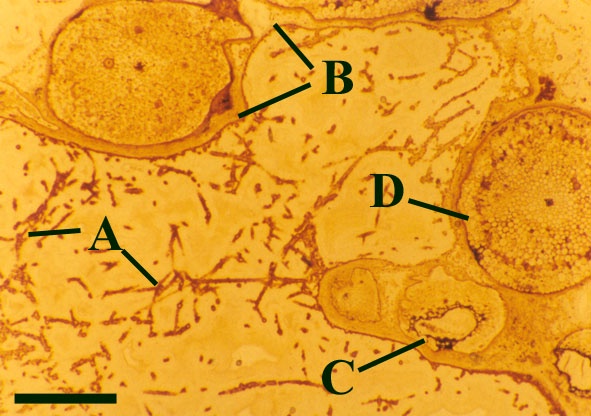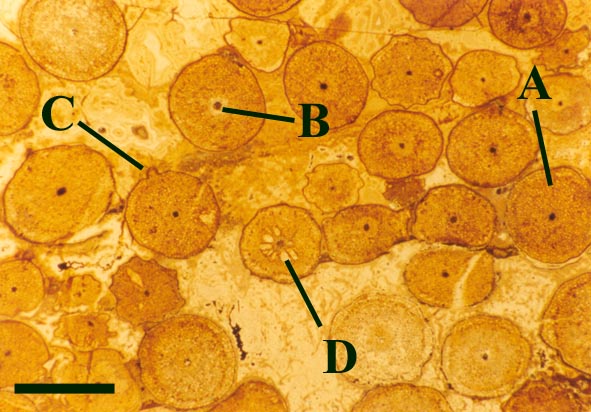Introduction
Assessment will generally need to be tailored to the requirements of the user institution, and course level. The following are suggestions for assessment methods.
Assessment Methods
Presentations at seminars can be assessed on both technical content and presentation skills. A selection of topics for short seminars is given.
A traditional examination can be set. Examples of examination questions are given.
Practical-based skills can be assessed by providing images for students to interpret. A selection of practical images is provided. Students can use these images and attempt to identify/interpret them on the basis of text and illustrations provided on the resource site. Tutors may access answers to these by clicking on the appropriate images.
Assessment Methods
- Report/Essay Subjects
-
Students can be asked to utilise the resource and to provide a report / essay on a general or specific topic. In this manner the course can also be used for 'distance learning'.
The following is a list of suggested written report or essay titles designed for students having studied the accompanying resource and using appropriate texts cited in the bibliography :
- The evolutionary significance of the Rhynie chert plants.
- The Rhynie hydrothermal system, origin, structure and geochemistry.
- The arthropod fauna of the Rhynie chert and its place in the record of terrestrialisation of animals.
- Reconstructing the depositional environment of the Rhynie chert - use of modern analogues.
- Palaeoecology of the Early Devonian Rhynie ecosystem.
- The role of fungi in the Early Devonian Rhynie ecosystem.
- A comparison of the Rhynie chert biota with the biota of sites of comparable age.
- Seminar Subjects
-
Presentations at seminars can be assessed on both technical content and presentation skills.
The following gives a list of suggested seminar titles designed for students having studied the accompanying resource and appropriate texts cited in the bibliography :
- History of research into the Rhynie chert.
- Origin of the Rhynie chert as a hot-spring deposit.
- What is a geothermal system?
- Terrestrial arthropods in the Rhynie chert.
- Aquatic arthropods in the Rhynie chert.
- The structure of one of the Rhynie chert plants (use any plant).
- Fossilisation in the Rhynie chert.
- Evolutionary importance of the Rhynie chert plants.
- Rhynie chert compared with modern sinters deposited from hot-springs.
- Source of the Rhynie hot-spring fluids.
- Composition of the Rhynie hot-spring fluids.
- Role of fungi in the Early Devonian Rhynie ecosystem.
- The life cycle of a typical terrestrial plant from the Rhynie chert - sporophytes and gametophytes.
- Plant spores in the Rhynie chert and associated sedimentary rocks.
- Exam Subjects
-
A traditional examination can be set.
The following is a list of suggested written examination questions designed for students having studied the accompanying resource and appropriate texts cited in the bibliography :
- Discuss the importance of the Rhynie chert flora to palaeobotany.
- Was the Rhynie chert flora typical of Early Devonian terrestrial/freshwater environments? Discuss.
- What is the evidence that the Rhynie chert was originally deposited as siliceous hot-spring sinters in the Early Devonian?
- Discuss the events that resulted in the preservation of Devonian plants in growth position in the Rhynie chert.
- Discuss the relationships of the Rhynie chert plants to extant taxonomic groups.
- Compare and contrast textural features of the Rhynie chert with those of modern hot-spring sinters.
- Discuss the Rhynie chert fauna in relation to modern arthropod faunas from similar environments.
- Discuss the evidence that shows that the plants found in the Rhynie chert were preserved both whilst living, and/or after various stages of decay.
- What is the evidence that the Rhynie chert plants and animals were terrestrial?
- Considering the alternation of generations in plants, describe the full life history of one of the Rhynie chert terrestrial plants.
- Image Interpretation
-
The following is a selection of thin section photographs taken from the Rhynie chert which may be given to students in the form of a practical assessment, having studied the accompanying resource and appropriate texts cited in the bibliography . The images are annotated with labels and scale bar so that students can attempt to identify the features highlighted.
Tutors may access the interpretations and answers of the following individual images:
Image 1

What are the features labeled A-D? Try and identify the plant stems. What problems are there in identifying these plants? The scale bar = 5mm.
A: Geopetal sediment in a plant straw
B: A xylem strand displaced during the decay and shrinkage of the plant stem
C: A cemented fracture cutting previously silicified plant axes and matrix
D: Shrunken and partially decayed axes
Plant: Straws of Aglaophyton major.
Problems: Many anatomical features have been lost prior to silicification due to the shrinkage and partial to almost complete decay of the plants. A few clues remain to identify them at the magnification in this photograph; partly the relatively large diameter of the axes but more specifically the pattern of cortex decay (bottom left) is primarily found in Aglaophyton. We cannot tell at this magnification if the xylem cells lack thickenings.Image 2

What are the features labeled A-D? Try and identify the plant stems. What can you deduce about the timing of silicification with respect to the taphonomy of the plants in this photograph? The scale bar = 2mm.
A: Well preserved cortex cells in a plant axis
B: Shrunken and partially decayed axes
C: Hemispherical projection
D: Vascular tissue: phloem surrounding a central xylem strand
Plant: Rhynia gwynne-vaughanii
Timing: With regards to taphonomy, the Rhynia axes show two distinct morphologies: some appear very fresh whereas others (e.g. B) appear shrunken. This suggests new stems were growing among older axes that were dying back. The almost complete cellular preservation in the fresh axes suggests the silicification must have occurred at or very soon after the death of the younger shootsImage 3

What are the features labeled A-D? Try and identify the plant axes. What type of axes are those in the centre and right of the image, and why? The scale bar = 1mm.
A: Xylem strand
B: Phloem cells
C: Remnant pore space, filled by blue-stained epoxy resin
D: Shrunken and partially decayed axis
Plant: Trichopherophyton teuchansii
Axes: These axes are most likely to be rhizomal axes of Trichopherophyton because they lack the characteristic spinose projections seen in the aerial axes. The epidermis of the axis in the centre of the image is papillate and displays a number of short blunt-tipped emergences, possibly representing rhizoids.Image 4

What are the features labeled A-D? Try and identify the plant stems. How would you distinguish between fungal hyphae, green algal (chlorophyte) and cyanobacterial filaments? What problems are there in identifying these in the Rhynie chert? The scale bar = 2mm.
A: Most likely fungal hyphae.
B: An organic-rich mucilaginous coating binding the plant stems.
C: A partially decayed plant stem.
D: An outer cortex layer.
Plant: Rhynia gwynne-vaughanii
Identification and problems: Fungal hyphae are generally larger, branched and tube-like and may have attached vesicles. Cyanobacteria and green algal filaments are a lot finer and smaller, usually consisting of chains of cells. Cyanobacteria, being prokaryotes, do not contain contain nuclei within their cells and may bear larger heterocysts within the filament chain. Problems of identification in the Rhynie chert are mainly due to variable degrees of preservation. For example, cell contents may not be preserved; some organic inclusions in cells may be taphonomic artifacts and filaments may just be preserved as ghost structures.Image 5

What are the features labeled A-D? Try and identify the plant stems. Are these plants in growth position or have they been transported? How can you tell? The scale bar = 3mm.
A: Inner cortex.
B: Vascular tissue - phloem and xylem strand.
C: Hemispherical projection with rhizoids.
D: Partially decayed cortex.
Plant: Rhynia gwynne-vaughanii
Growth position or transported: These stems are most likely in growth position because they all show the same alignment with very little cellular decay, and they are not fragmentary. Also there are no fragments of other plant species and very little detrital material present.
